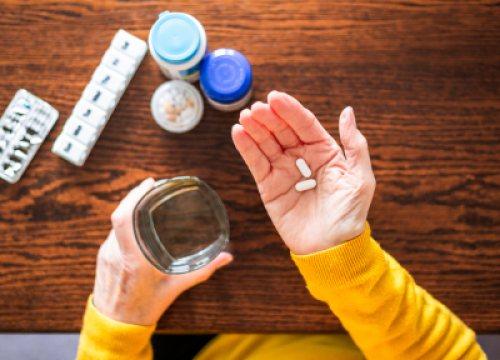Constipation & Nausea

Difficulty swallowing, feelings of nausea and constipation are all common symptoms of Parkinson’s disease (PD). Scientists point to two explanations for these difficulties. The same brain changes in PD that cause stiffness and slow movement also affect the muscles involved in swallowing and in pushing food through the digestive system.
Additionally, Parkinson’s can affect the nerves that line the digestive tract, called the enteric nervous system. In particular, researchers have found Lewy bodies in neurons lining the intestines of people with PD. This suggests cell damage in the gut may signal the beginning of PD and cell death in the brain is a relatively late stage of disease.
Constipation
Constipation, defined as fewer than three bowel movements per week and frequently accompanied by straining, hard stools, or a sensation of incomplete emptying, is perhaps the most widely recognized gastrointestinal symptom of Parkinson’s. Studies have shown that constipation often begins before motor symptoms. In one study, researchers found that having a bowel movement less often than once a day indicated a four times higher risk of developing Parkinson’s.
In some people with PD, constipation may occur due to the improper functioning of the autonomic nervous system, which is responsible for regulating smooth muscle activity of the gut. If this system is not working properly, the intestinal tract may slow down, causing constipation. Medications for PD, including levodopa and dopamine agonists, as well as amantadine and trihexyphenidyl, may also cause or contribute to constipation. Other causes include:
- Not drinking enough water
- A diet low in fiber
- Lack of exercise
- Resisting the urge to have a bowel movement
- Weakness of the pelvic floor muscles
- Medications: iron supplements, opioid pain medications, antacid medicines containing calcium or aluminum, certain antidepressant and blood pressure medications
- Medical problems such as irritable bowel syndrome (IBS), thyroid disease, diabetes and colorectal cancer. Abrupt onset of constipation, especially if severe, is not typical in Parkinson's disease and warrants further evaluation.
How to avoid constipation
There is no specific treatment, but avoiding known causes of constipation and keeping the stool soft should help. Some people with PD will need further treatment for constipation through their health care team.
- Eat a well-balanced diet with plenty of fiber. Good sources of fiber include fruits, vegetables, legumes, bran, and whole grain bread.
- Add fruits and vegetables to your diet.
- Eat prunes and/or bran cereal.
- Drink 48 to 64 ounces of water each day.
- Exercise daily.
- Drink warm liquids, especially in the morning. Consider warming your prune juice instead of drinking it cold.
- If needed, add an over the counter fiber supplement or stool softener.
- Laxatives, suppositories, and enemas can also be used but you should first discuss this with your doctor.
Nausea
Nausea or bloating can result when the stomach empties its contents into the small intestine too slowly, a condition called gastroparesis. For people taking levodopa, this slow transit is a problem because the drug cannot be absorbed by the small intestine and travel to the brain. There is testing available for gastroparesis (gastric emptying study) but treatment options are limited.
It is important to know that some medications given for nausea and gastroparesis work by blocking dopamine which can be counter-productive to a person’s PD motor symptoms. Inhaled levodopa or sublingual dissolvable films may help in this situation by allowing for better absorption by partly or wholly avoiding the gastrointestinal tract but they can only be used as supplemental, not primary therapy for PD. New delivery systems for dopaminergic therapy, such as a subcutaneous pump, are being tested in clinical trials.
Nausea also commonly occurs as a side effect of levodopa therapy. In this case, nausea usually occurs after starting the medication. Your doctor may advise taking the medication with food. If that is not effective, the total amount of carbidopa you take may be increased. Each levodopa tablet also includes carbidopa, a compound used to reduce side effects such as nausea.
A typical dose of carbidopa-levodopa is 25/100mg: this refers to 25mg of carbidopa and 100mg of levodopa. Additional tablets of carbidopa can be added separately and are more likely to be helpful when the total daily amount of carbidopa is less than 100mg. For example, 1 tablet of carbidopa-levodopa 25/100mg three times daily, which is a typical starting dose in PD, only reaches 75mg of carbidopa.
Be aware that any sudden onset vomiting or vomiting associated with weight loss or bleeding requires prompt evaluation for causes unrelated to Parkinson’s.
Page reviewed by Dr. Addie Patterson, Movement Disorders Neurologist at the Norman Fixel Institute for Neurological Diseases at the University of Florida, a Parkinson’s Foundation Center of Excellence.
Related Materials
Related Blog Posts


Parkinson's Medications 101
